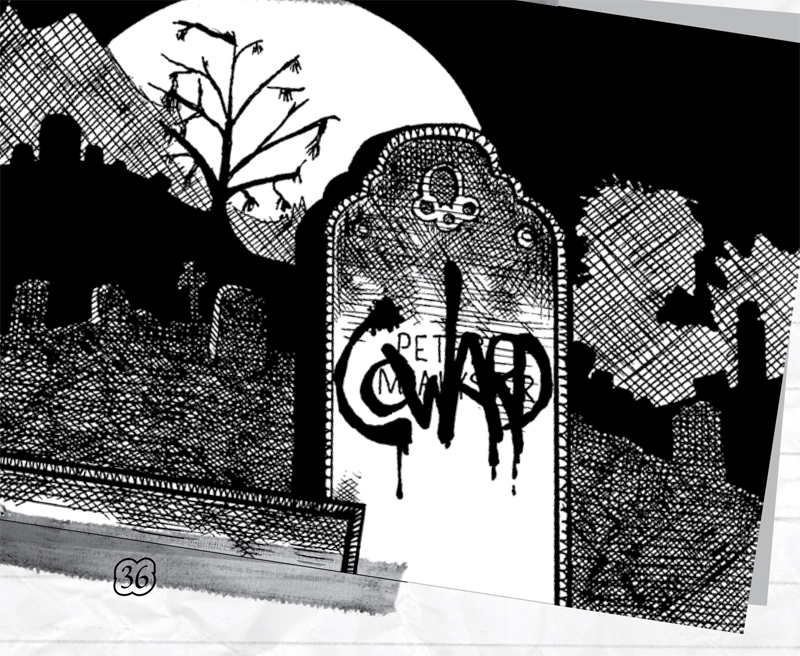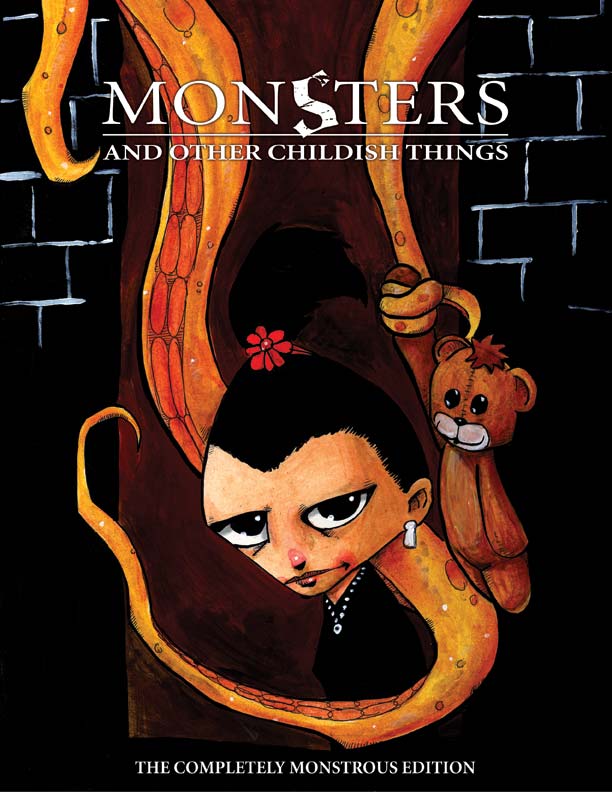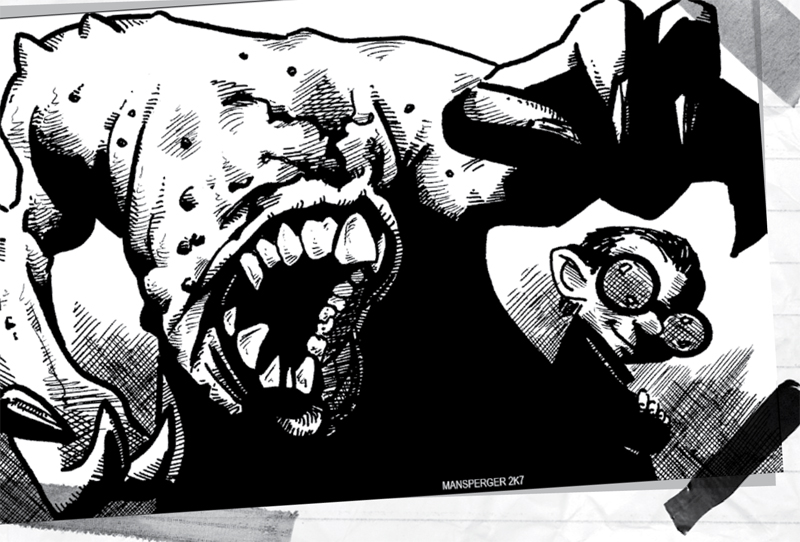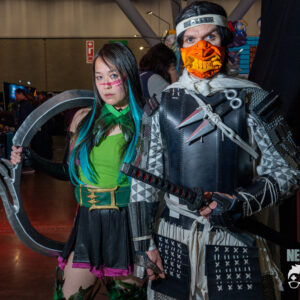Parents, & Teachers, & Radioactive Monstrosities from Beyond Space-Time, Oh My! Reviewing Monsters and Other Childish Things
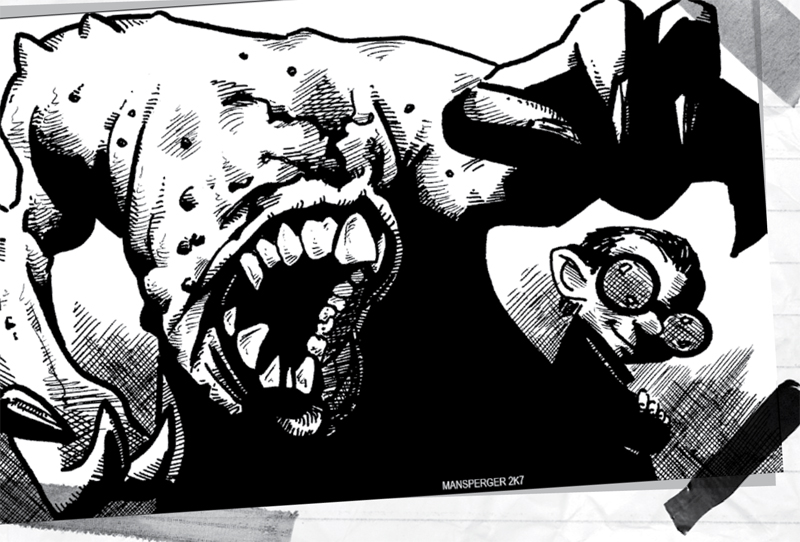
In Monsters and Other Childish Things, players take the role of ordinary kids – powerless, playful, and put upon – with vicious and single-minded monsters looking out for them. Hilarity ensues. Or horror. Or both.
Published by Cubicle Seven, the latest “pocketbook” edition of the game is a solid trade paperback with spooky black-&-white (but mostly black) internal illustrations and a clever, but still legible, “wrinkled notebook” look to the pages.
Author Benjamin Baugh writes in friendly conversational tone, with that most important of gaming book quality – infectious enthusiasm. Starting as he means to go on, he gives us an introduction that is concise and useful. He begins by describing the triumvirate of M&OCT: kids, monsters, and relationships. Then we have a brief overview of the rules, character creation, and play. This is really helpful and gives the reader a great idea of what the game is and how it’s played. There are even page numbers for the relevant chapters if you can’t wait. So useful is the introduction that if you lost the rest of the book (say, in a conflagration), you could, with a little work, run the game with just the intro.
In the “Characters” chapter we have both character creation and the dice mechanic in detail (a simplified version of the popular One Roll Engine). Players begin by allotting dice to a nice selection of childish Stats (Feet, Guts, Hands, Brains, and Face) and Skills (P.E., Courage, Out-think, Putdown, etc.). Then players create, and allot dice, to a handful of important Relationships. Stats and Skills are combined to form a dice pool, which is rolled when attempting any tricky task. Instead of trying to roll high or low, however, players in M&OCT are trying to roll matching sets: a pair of “5s” or four “2s” (the game uses d10s). These matches each have a “Width” and a “Height”, being the number of matching dice and the value of the matches, respectively. This allows each roll to represent a number of different things: Width is a measure of speed and power, while Height represents accuracy and finesse. It’s an unusual system that requires a bit of getting used to, but it is also pretty ingenious.
Relationships are very important to M&OCT and have real effects on the system. A relationship can be anything that a child is attached to: Mom, Todd, My Bike, etc. (a child’s relationship with her monster is called a Bond and treated differently). Each relationship is given a number of dice representing the strength of the relationship (“Dad 3,” or “Rubber Duck 4”). These relationship dice can be added to any roll that the player (& GM) deems relevant to the relationship. So if your kid is racing a go-kart that her dad helped her build she can add some of her Dad relationship dice to the roll. Similarly, if your character brought her “lucky duckie” to her math quiz she could use some of her Rubber Duck dice. There is a danger of course: if a child fails a roll in which she used relationship dice, that relationship takes damage (she loses some faith in her Dad/Duck) that reduces its effectiveness, causes in-story tension, and takes dedicated role-playing to heal.
The “Conflict” chapter offers comprehensive rules for both physical and emotional combat. Both types of combat use an opposed version of the game’s main mechanic (stat + skill + relationship vs. stat + skill + relationship) and both cause damage in the same way, reducing the effectiveness of individual stats. The difference lies is how the damage is healed and what it means story-wise: physical damage is familiar and obvious; emotional damage represents shame, fear, depression, etc., and decreases stats by way of shaky hands, nauseated stomach, crying, and the like. Healing emotional damage requires the commiseration and support of friends and family, and role-playing. I really liked this chapter, not only for its simple yet thorough rules, but because it starts with a section entitled “Avoiding Conflicts.” This is a nice touch, and an acknowledgment that sometimes children – even children with pet monsters – turn around and run away, and that sometimes it’s for the best.
The heart of M&OCT is, of course, the monsters. In Monster 101 we learn that “monsters aren’t from around here,” “monsters are good at hiding,” “monsters can’t die,” and “nothing can stop a monster except another monster.” Beyond these basics, the game makes no attempt to explain the monsters whatsoever. What are they, exactly? Where do they come from? What do they want? Baugh waves aside these questions with vague statements like “beyond space and time” and “Somewhere Else”. This mystery nicely reinforces the uncertainty and the just-because-ness of childhood. Actually, we do know what monsters want: monsters have an unshakeable and unconditional love for their children. And kids have and almost psychic bond with their monsters – seeing his monster take physical damage causes a child emotional damage. And vice versa, when a child receives emotional damage, his monster takes physical damage.
Detailed rules are provided for creating monsters of almost any description, including personality, ways to hide, and awesome powers! There are rules for monsters vs. people combat (messy and short) and monster vs. monster fights (much more sporting). Finally there are the nasty facts that monsters eat not only bits of other monsters but relationships, both those loaned them by their own child and those belonging to the child of a thoroughly defeated monster. Eating bits of other monsters involves decreasing the bitten monster’s stats to increase the biter’s. Loaned relationships work just the same as when kid uses his relationship dice to add to his own dice pool, except he is adding them to his monster’s dice instead, with the same consequences for failure. Eating another monster’s kid’s relationship dice occurs when the loser has been completely beaten and is truly horrific, potentially reducing the loser’s child to an isolated, empty sociopath.
Those are the rules and about a third of the book. The rest of the pages are dedicated to advice and tools for playing the game, what Baugh calls “GM-Fu”. There is advice on weaving the PCs’ relationships into stories, creating NPCs on the spot, and single session vs. long-term games. Themes of childhood such as powerlessness, “adventure,” and the petri dish that is school, are all explored as well as ways of incorporated them into a game. We are also introduced to the idea of Grade Levels: monster-loving kids in elementary, junior high, or high school, and the different themes, interests, and dangers of each.
Whole chapters are devoted to sample kids (and their monsters), antagonists, and miscellaneous NPCs. The characters are all well-rounded and interesting and present some great inspiration (my favorites being the Wannabe Wizard, the Alien Math Teacher, and the Monster-obsessed Mad Science Teacher – think Mr. Crocker from Fairy OddParents).
M&OCT doesn’t have a setting, instead Baugh gives us a few “Campaign Jumpstarts:” brief descriptions of three different setting – with themes, Grade Level, and adventure hooks – that GM can expand upon. First up is “Welcome to Pluto,” a high school campaign based in Pluto, CA. This is a living-with-weirdness setting where people have gotten used to the existence of monsters. The author sites Veronica Mars and Brick as inspiration, but the description put me in mind of Christopher Moore’s Pine Cove. The second mini-setting , “the XMFL” (eXtreme Monster Fighting League), is a demented Pokemon complete with prize-fights, slimy TV executives, and soul-crushing fame. Lastly, we have “Ugly Secrets”, the most “realistic” and potentially horrifying of the campaign jumpstarts. In this scenario the PCs are ordinary elementary children in an ordinary world who have just acquired monsters.
After the mini-campaigns, we have “What Did You Get for Christmas” a sample adventure using many of the sample NPCs from earlier in the book. In this adventure, the PCs have all acquired monsters during Christmas break and are now returning to school. But word is out among the monster-hunters, occultists, and alien weirdoes, and the PCs find themselves the target of competing conspiracies. It’s a fun adventure that occupies a middle ground between the “realism” of “Ugly Secrets” and the craziness of “Welcome to Pluto”, with the potential for things to get hilariously or frighteningly out-of-hand. (There is also a sidebar with a fantastic idea for adding some real life arts & crafts to your gaming table.)
Monsters and Other Childish Things is a fun read and a fun game. The one-roll system is ingenious, if unusual. By giving them real system significance, the game makes character relationships truly matter. Children and childhood are deftly handled, being uncertain and wondrous without being maudlin or puerile. The monsters themselves are great role-playing devices, tailor-made for creating havoc and encouraging player responsibility. Rather like colossal fire-breathing puppies, really. I was disappointed with the lack of a setting, but the campaign jumpstarts went a long way towards alleviating my concerns.
Monsters and Other Childish Things reminds me a lot of Little Fears, another game of kids and monsters, but whereas Little Fears is clearly a horror game of children battling monsters, in Monsters and Other Childish Things the monsters and kids are in cahoots. Whether this makes the game horror and/or comedy will depend on the GM and her players.


